中文词条原文链接(无法从中国内地访问):请点击这里访问
英文词条原文链接(无法从中国内地访问):请点击这里访问
本文基于英文词条的线索,并补充部分来自中文词条的内容(在二者冲突时,以更晚更新者为准)。辽观搬运时进行了必要的合规化处理,以使其能够在中国内地上传。维基百科(Wikipedia)是美国维基媒体基金会的互联网百科项目,其内容可能受到立场、信息来源等因素影响,请客观看待。正文内容不代表译者观点。
辽观提供的翻译仅供参考。文中可能包含无法从中国内地访问的链接。
辽观所搬运的词条文本与维基百科一道同样遵循CC BY-SA 4.0协议(辽观搬运的中英文对照版本),在符合协议要求的情况下您可以免费使用其内容(包括商用)。图片和视频可能遵循不同的共享协议。请点击这里访问
茅台酒是一种酱香型大曲白酒,原产于贵州省遵义市茅台镇。茅台酒气味芬芳香醇浓郁,不论气味与口感均散发强烈香气。同时是中国四大名酒“汾茅五剑”第二。在西方,该酒经常因其高烈度与浓烈口感,经常被与俄罗斯伏特加酒比较。
Maotai or Moutai (simplified Chinese: 茅台; traditional Chinese: 茅臺; pinyin: máotái) is a style of baijiu made in the town of Maotai, Guizhou Province, China. Maotai is made from sorghum, a wheat based qū, and water from the Chishui River, and it uses traditional Chinese techniques of fermentation, distillation, and aging, to produce a spirit with a unique nutty, grain forward, and in many ways savory aroma and flavor.[1][2]
【参考译文】茅台(简体中文:茅台;繁体中文:茅臺;拼音:máotái)是一种产自中国贵州省茅台镇的白酒风格。茅台酒由高粱、小麦制曲以及赤水河的水酿造而成,采用中国传统发酵、蒸馏和陈年技术,酿造出具有独特坚果香、突出谷物风味、在很多方面还带有鲜美香气和味道的烈酒。[1][2]
The most famous and certainly best selling manifestation of maotai is produced by Kweichow Moutai, so successful in fact that it has become the most valuable spirits brand not just in China but in the world as a whole.[3] However, despite common misconception, Kweichow Moutai is not the only producer of maotai, nor do they own any exclusive right to the name. Maotai must simply be produced in the town of Maotai and follow the production guidelines as laid out in regulation.
【参考译文】茅台酒中最著名且无疑最畅销的品种是由贵州茅台生产的。事实上,贵州茅台非常成功,不仅成为中国价值最高的烈酒品牌,也是全球价值最高的烈酒品牌。[3]然而,尽管普遍存在误解,贵州茅台并非唯一生产茅台酒的厂家,也不拥有茅台这一名称的独家使用权。茅台酒只需在茅台镇生产,并遵循相关规定的生产工艺标准即可。
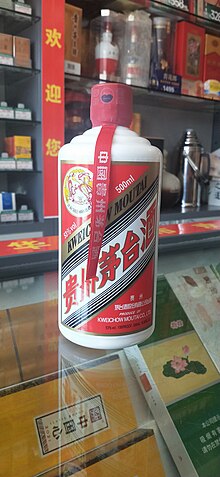
图片作者:毕明明
此图片遵循CC BY-SA 4.0协议
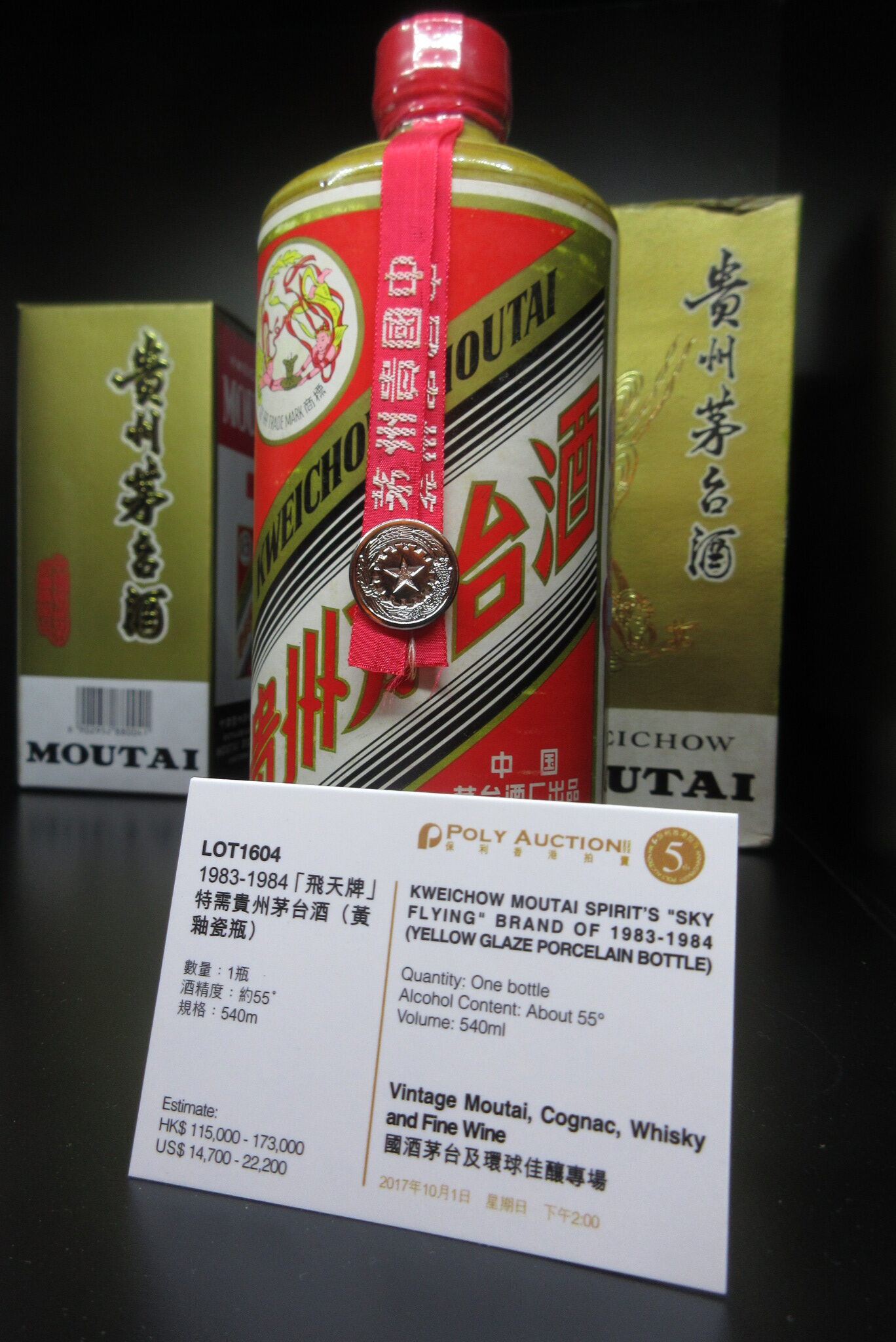
参考译文:在2017年香港的一场拍卖会上,一瓶生产于1983-1984年的茅台酒的预估价格范围为115,000港币至173,000港币(约合14,700美元至22,200美元)。
图片作者:HunagnTwuai
此图片遵循CC BY-SA 4.0协议
1. 历史 | History
1.1 古代
辽观注:此标题是我们在搬运、整合过程中添加的。
一种说法是,历史名酒“枸酱”即为茅台的雏形。西汉建元6年(公元前135年),汉武帝派唐蒙出使南越(今广州)。其间唐蒙得饮名酒“枸酱”,感觉酒味绝美,回到长安后,向蜀商咨询,蜀商说“独蜀出枸酱,多持窃出夜郎。”于是唐蒙绕道取枸酱酒献汉武帝。汉武帝以“甘美之”赞叹,视为珍奇,当时即为贡品,故有“唐蒙饮枸酱而使西域”之说。清代诗人陈熙晋写道:“尤物移人付酒怀,荔枝滩上瘴烟开,汉家枸酱知何物,赚得唐蒙习部来。”
Alcohol production in Zunyi, on the banks of the Chishui River, has a long history dating back to at least the 1st and 2nd centuries BCE where there is record of Han dynasty Emperor Wu tasting and praising a goqijiu produced in Yelang. However, it wasn’t until the Tang and Song dynasties that grain based distilled alcohols began to develop in China as a whole.[4][5]
【参考译文】遵义市位于赤水河畔,其酿酒历史源远流长,至少可追溯到公元前1世纪至公元2世纪,有记录显示汉武帝品尝并赞扬了夜郎地区生产的浊酒。然而,直到唐宋时期,以谷物为原料的蒸馏酒精饮料才开始在中国全面发展。[4][5]
The origins of Maotai itself, and the distilleries that preceded Kweichow Moutai lie in the Qing dynasty when Beijing officials of the salt monopoly, stationed at an outpost in Maotai, introduced baijiu production methods from the north (qingxiang) which ultimately merged with the then in-use methods from neighboring Sichuan (nongxiang).[6] The result of this blend of techniques served as the basis for jiangxiang baijiu and more particularly for maotai itself. The earliest explicit record of maotai is in 1704, where in Renhuai Caozhi, a local newspaper, it was written that “Moutai Village in the west of the city ranks first in the whole country for making liquor.”[5]
【参考译文】至于茅台酒本身及其先于贵州茅台的酿酒厂的历史,则可追溯到清朝。当时,驻扎在茅台镇的盐务官僚从北方(清香型)引入了白酒生产工艺,这些工艺最终与四川邻近地区当时使用的工艺(浓香型)相融合。[6]这种技术融合的结果成为了酱香型白酒的基础,尤其是为茅台酒本身奠定了基础。茅台酒最早明确的记载出现在1704年,在当地报纸《仁怀草志》中写道:“城西茅台村制酒,全省称第一。”[5]
茅台镇在清嘉庆、道光年间造酒已初具规模,据《遵义府志》记载:“茅台酒,仁怀城西茅台村制酒,黔省称第一。茅台烧房不下二十家,所费山粮不下二万石”。光绪年间,“茅春、茅台烧春、回沙茅台”已远销诸省,其独特工艺也大体定型。所酿之酒曰“茅台烧”。但古酿造作房被太平天国翼王石达开进攻贵州时所毁。
图片题注:Vintage Maotai in the more common white porcelain bottles displayed in the same auction.
参考译文:在同一场拍卖会上,展出了更常见的白瓷瓶装的年代茅台酒。
图片作者:HunagnTwuai
1.2 近现代
辽观注:此标题是我们在搬运、整合过程中添加的。
In 1854, during the Taiping Rebellion the town of Maotai was destroyed and all of the distilleries reduced to ruins or abandoned completely. Nine years later, in 1863 a salt merchant from a neighboring town bought one of the abandoned distilleries, hired a retired master distiller, and resumed the production of maotai in the newly founded “Chengyi” distillery and sixteen years later, in 1879, three Renhuai landlords opened the “Ronghe” distillery. It’s with these two distilleries that many of the techniques and profiles of contemporary maotai were finalized. At the beginning of the 20th century, with the fall of the Qing dynasty and the birth of the Republic of China, maotai continued to be in demand with “tribute liquor” being crafted at the request of the short lived Chinese leader Yuan Shikai for the occasion of his coronation as emperor. In that same year, maotai was presented at the 1915 Panama-Pacific Exposition and awarded a Gold Medal[7] at the 1915 Panama-Pacific Exposition which spurred a rapid increase in demand for the spirit within China and in response a rapid increase of production capacity for the two distilleries. In 1929 the third distillery “Hengxing” was founded and it is on the foundation of these three distilleries that Kweichow Moutai was to be built.[5]
【参考译文】1854年,在太平天国运动期间,茅台镇被摧毁,所有酒厂都被破坏或完全废弃。九年后的1863年,一位来自附近城镇的盐商购买了其中一个废弃的酒厂,聘请了一位退休的大师级蒸馏师,并在新成立的“成义”酒厂恢复了茅台的生产;十六年后的1879年,仁怀三位地主开设了“融和”酒厂。正是这两家酒厂最终确定了许多当代茅台的技术和特色。20世纪初,随着清朝的覆灭和中华民国的建立,茅台继续受到追捧,“贡酒”应中国短命领袖袁世凯的要求而被制作,用于他加冕为皇帝的仪式。同年,茅台还在1915年的巴拿马太平洋博览会上展出,并获得了金牌奖,这促使中国国内对这种酒的需求迅速增加,作为回应,这两家酒厂的生产能力也迅速增加。1929年建立了第三家酒厂“恒兴”,基于这三家酒厂的基础,贵州茅台得以建立。
Maotai’s importance in contemporary China has many of its roots in the era of the Chinese Civil War. It was in Zunyi, the prefectural city over the town of Maotai that Mao Zedong became the leader of the Chinese Communist Party at the Zunyi Conference and it was during the Long March that many Chinese troops and many of China’s future leaders, including Zhou Enlai would gain an appreciation for maotai.[4][6] Stories from the time recount Red Army soldiers and officers enjoying maotai both for consumption and for more practical purposes, primarily the cleaning and disinfection of the soldiers feet.[8] In “Memoirs of the Long March” the author Cheng Fangwu wrote; “Because of the urgent military situation, we dared not drink much liquor. The liquor was mainly used to wipe our feet and relieve fatigue on the road. Wiping feet with the maotai is effective. Everyone praises it.”[9] In a likely apocryphal story, company commander Wang Yuenan, and one of Mao’s guards Chen Fengchan, were in returning from a trip to purchase maotai for this very purpose when they ran into Mao himself who told them; “Maotai is a place famous for its wine, but it would be a pity to wipe your feet with this wine!”[4] While in the town of Maotai during the Long March, the political bureau of the Red Army issued a notice to the passing soldiers to note the importance of maotai liquor and refrain from interfering in the private distillation of the spirit ongoing except to buy or sell.[8]
【参考译文】茅台酒在当代中国的重要性在很大程度上源于中国内战时期。毛泽东在遵义市成为中国共产党领导人的地点,而遵义又是茅台镇上的一个地级市。在长征期间,许多中国部队和中国未来的领导人,包括周恩来,都开始欣赏茅台酒。当时的故事中记载着红军士兵和军官们享用茅台酒的情形,不仅用于饮用,还用于更实际的用途,主要是清洁和消毒士兵的脚。在《长征回忆录》中,作者程方武写道:“由于当时军事形势紧急,我们不敢多喝酒。酒主要用来擦拭我们的脚和缓解路上的疲劳。用茅台擦脚很有效。每个人都称赞它。”据说,连长王月南和毛泽东的保镖陈凤璨正在为这个目的购买茅台酒回来时,偶然遇到毛泽东本人,后者对他们说:“茅台是一个以酒而闻名的地方,但用这酒擦脚实在太可惜了!”在长征途中,红军政治局在茅台镇发布通知,告诉经过的士兵要注意茅台酒的重要性,除了购买或出售外,不要干涉正在进行的私人蒸馏行为。
图片题注:Maotai in red special version bottles
参考译文:红色特别版瓶装的茅台酒。
图片作者:HunagnTwuai
Shortly after the end of the Chinese Civil War and after the founding of the People’s Republic, the three existing maotai distilleries, Chengyi, Ronghe, and Hengxing were merged to create the modern, state-owned Kweichow Moutai in 1951.[10]
【参考译文】内战结束后不久,新中国成立后,三家现有的茅台酒厂(成义、融和、恒兴)于1951年合并,创建了现代的国有企业——贵州茅台。
Since the foundation of the modern Kweichow Moutai, the spirit has served as part of the standard fare for Chinese diplomatic meetings and dinners. From Mao’s gifts of maotai given to Joseph Stalin and Kim Il-Sung in 1950 and 1973 respectively,[5] to Zhou Enlai’s use of the spirit as a diplomatic tool for the 1954 Geneva Conference[11] and the welcoming banquet for Richard Nixon 1972 visit to China,[12][13] maotai has served as one of the primary cultural items representing China on the international stage.[14] Its use in these terms has become so well known that when Deng Xiaoping visited the United States in 1979, Henry Kissinger told him “I think if we drink enough Moutai we can solve anything.”[14]
【参考译文】自贵州茅台成立以来,这种酒就成为中国外交会议和宴会的标配之一。从毛泽东分别在1950年和1973年赠送茅台给约瑟夫·斯大林和金日成,到周恩来在1954年日内瓦会议上将这种酒用作外交工具,再到1972年为尼克松访华的欢迎宴会,茅台一直是代表中国在国际舞台上的主要文化物品之一。其在这些方面的应用已经广为人知,以至于邓小平访问美国时,亨利·基辛格告诉他:“我认为如果我们喝足够的茅台,我们可以解决任何问题。”
2. 台湾茅台酒
1949年中华民国政府撤台时带走了茅台酒厂珍藏的原浆酒,还带走了酿酒师, 以及制酒配方、酒曲、基酒等,以此为基底承袭茅台酒的酿造工艺,酒精浓度为53度浓香型大曲高梁酒,不似酱香型茅台因正丁醇、异丁醇较多而带苦味。
1974年由当时台湾专卖局嘉义酒工场开始研制茅台酒,至1975年研制成功,于1977年推出上市,现由台湾烟酒公司嘉义酒厂生产,酒精浓度为54度。包装规格有两种,0.3升玻璃瓶装、0.5升白色瓷瓶装。于1999年改包装冠以“玉山”品牌销售至今。1978年、1996年、2002年、2004年年获世界烟酒评鉴会银质奖,2020年获旧金山世界烈酒竞赛SFWSC金牌,国际葡萄酒暨烈酒竞赛IWSC银牌,布鲁塞尔烈酒竞赛CMB金牌,2021年获国际烈酒挑战赛ISC双金牌。[1]
3. 贵州茅台集团
主条目:贵州茅台集团
1950年代初,中华人民共和国政府进行公私合营。将原三家最主要的茅台镇私人烧坊,即出产王茅的荣和烧坊(经理王秉干)、出产华酒, 又称“华茅”的成义烧坊(创始人华联辉)、和出产赖永初酒,又称“赖茅”的恒兴烧坊(经理赖永初)、合并成立国营茅台酒厂,以原恒兴烧坊业主赖永初为新厂主管。三家烧坊均献出其祖传茅台酿造配方,由新厂优选改进,投入生产。1952年第一届全国评酒会将茅台酒评为名酒,在白酒中排名第一。当时评出的名酒中只有四种白酒,因此后来将茅台等四种酒称为中国四大名酒。其后在1963年第二届全国评酒会和1979年第三届全国评酒会上分别评出的八种白酒里,茅台均排名第一,所以后来又将茅台等八种酒称为中国八大名酒。在1983年第四届全国评酒会和1989年第五届全国评酒会上,茅台又双双夺得第一。
大跃进时中国各地频“放卫星”,毛泽东亲自干预茅台生产,于1958年提出要“产量搞上一万吨”;[2]然后产量经过连级跳,从57年的283吨变成60年的912吨。[3]
3.1 改革开放后
最右侧为茅台王子酒,其口感与色泽均非上乘
图片作者:Xiaomage de
茅台酒的酿制技艺获得国家级非物质文化遗产。市面上正规专卖店和大卖场渠道销售的大多数都是53°和38°飞天、五星茅台酒,贵州茅台酒股份有限公司还生产了面向中低端市场的茅台王子酒、茅台迎宾酒和贵州大曲。除传统的中国白酒之外,茅台集团还生产啤酒和利口酒等产品。另外还有贵州茅台集团技术开发公司这一旗下企业,以集体品牌的形式生产各种价格低廉的茅台酒,但多以浓香型为主,一定程度上混淆了市场。随着茅台酒厂产能扩大,将越来越能够满足一定的国内市场需求,但是从原产地产量极限来说,茅台酒始终将是一种稀缺商品。
3.2 21世纪
茅台酒近年来价格不断上涨,2011年贵州茅台向争议性组织世界奢侈品协会“申请”“奢侈品资格”引发争议。加之中国大陆屡有国有企业花费巨款购买茅台等名酒的事件被曝光,遂使“茅台”经常与“公款吃喝”、“三公消费”、“腐败”等词语同时出现在热点话题中,成为网民调侃讽刺的对象。在2012年中央八项规定出台前,一些经销商为了优先保证单位团购,只有剩下的茅台才向普通民众销售,因此茅台酒时常出现断货。当时在茅台酒厂的自营零售店购买茅台酒需要出示身份证,每人限购两瓶,且需要排队才能买到。八项规定出台后,白酒的公款消费受到严格限制,茅台酒过去一度被炒起来的虚高价格出现下降,对民众的供应量也恢复正常。[4]。2020年茅台酒经销商再度爆炒贵州茅台酒,市场价格高达3000多元/瓶,至年底,茅台集团逼迫做出所有茅台酒必须以1499元/瓶拆箱散瓶销售政策,导致黄牛党炒作茅台酒纸箱500元/个的倒卖丑闻。


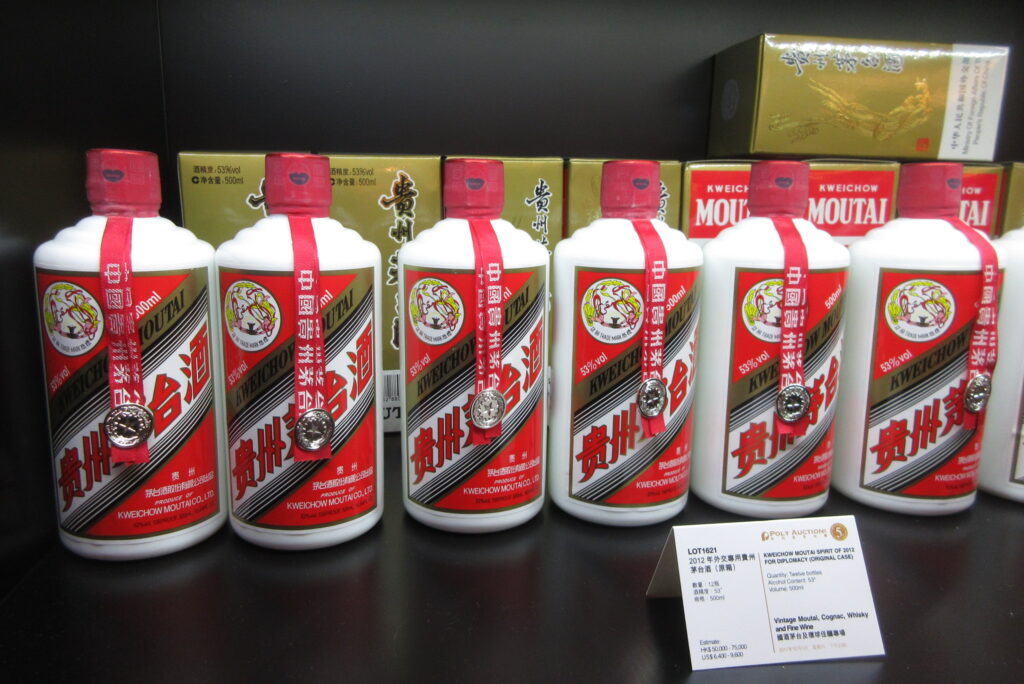
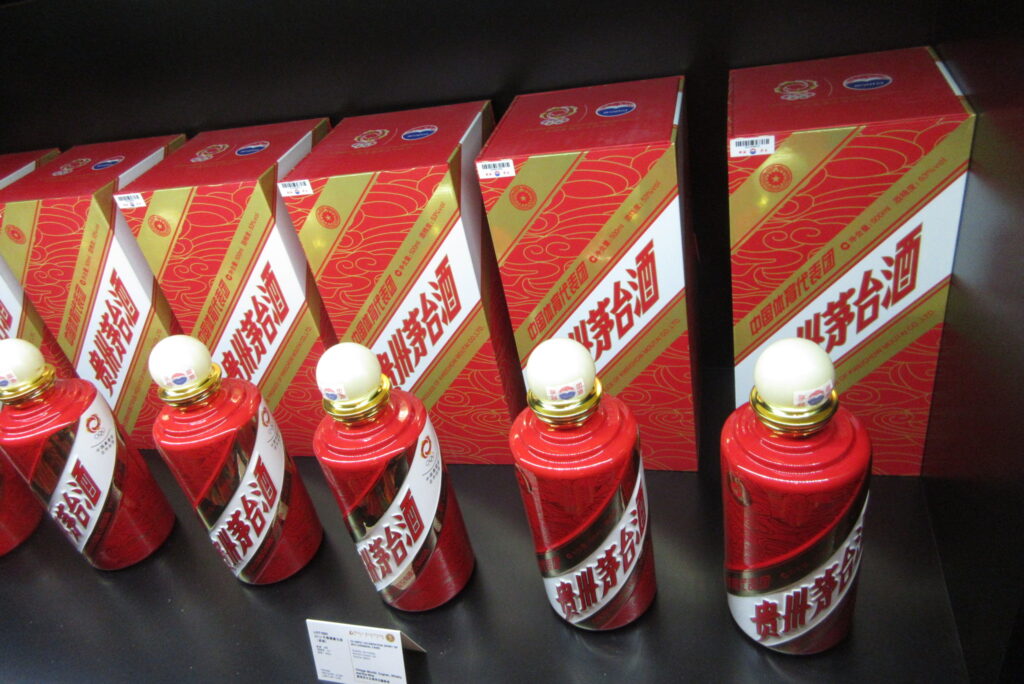
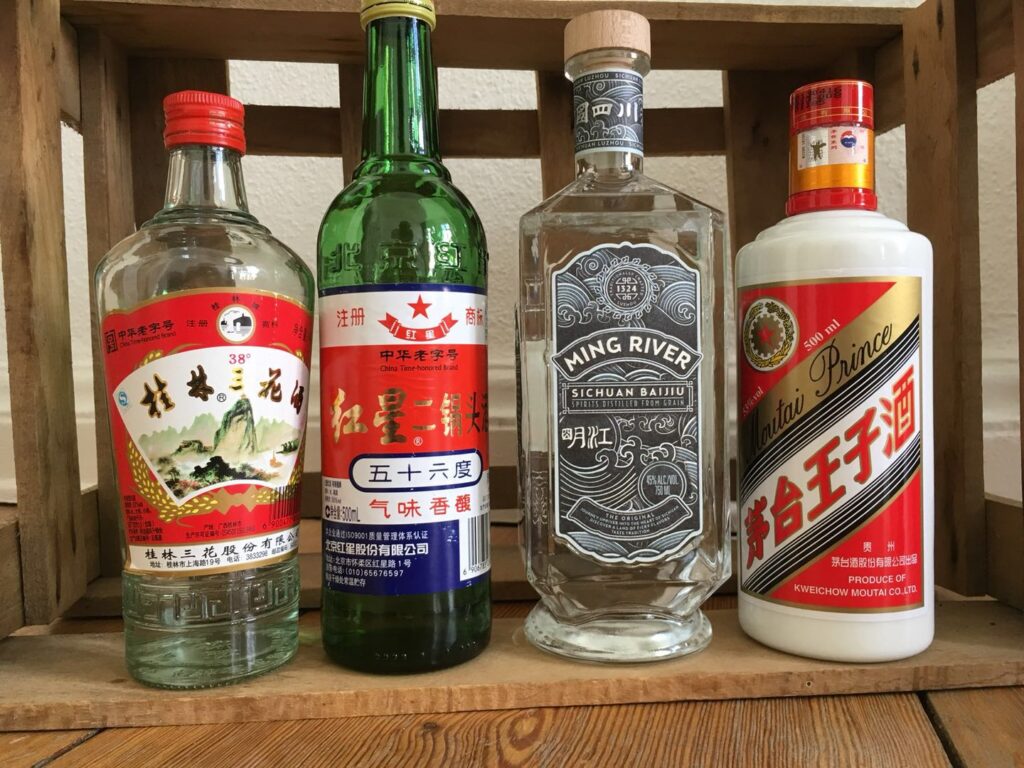
分享到: